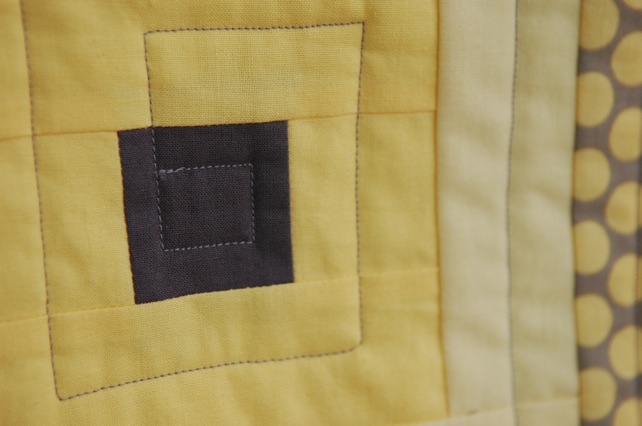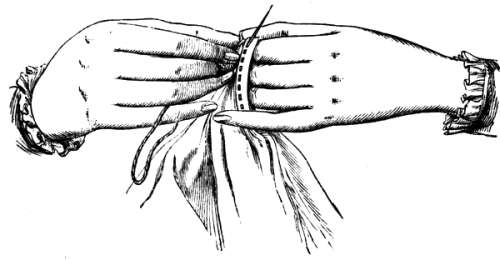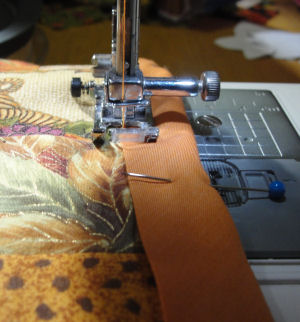|
Seam (sewing)
In sewing, a seam is the join where two or more layers of textile, fabric, leather, or other materials are held together with stitch (textile arts), stitches. Prior to the invention of the sewing machine, all sewing was done by hand. Seams in modern mass-produced household textiles, sports, sporting goods, and ready-to-wear clothing are sewn by computerized machines, while home shoemaking, dressmaking, quilting, crafts, haute couture and tailoring may use a combination of hand and machine sewing.Schaeffer (2001), p. 35 In clothing construction, seams are classified by their ''type'' (plain, lapped, abutted, or French seams) and ''position'' in the finished garment (center back seam, inseam, side seam). Seams are ''finished'' with a variety of techniques to prevent raveling of raw fabric edges and to neaten the inside of garments. The most common standard for seams is ASTM International ASTM D6193-16(2020) This standard also covers various types of Stitch (textile arts), stitch ... [...More Info...] [...Related Items...] OR: [Wikipedia] [Google] [Baidu] |
Quilting Seam
Quilting is the process of joining a minimum of three layers of textile, fabric together either through stitching manually using a Sewing needle, needle and yarn, thread, or mechanically with a sewing machine or specialised longarm quilting system. An array of stitches is passed through all layers of the fabric to create a three-dimensional padded surface. The three layers are typically referred to as the top fabric or quilt top, Batting (material), batting or insulating material, and the backing. Quilting varies from a purely functional fabric joinery technique to highly elaborate, decorative three dimensional surface treatments. A wide variety of textile products are traditionally associated with quilting, including bed coverings, home furnishings, garments and costumes, wall hangings, Quilt art, artistic objects, and cultural artifacts. A quilter can employ a wide range of effects that contribute to the quality and utility of the final quilted material. To create these ef ... [...More Info...] [...Related Items...] OR: [Wikipedia] [Google] [Baidu] |
Stitch (textile Arts)
In the textile arts, a stitch is a single turn or loop of thread, or yarn. Stitches are the fundamental elements of sewing, knitting, embroidery, crochet, and needle lace-making, whether by hand or machine.Picken (1957), p. 322 A variety of stitches, each with one or more names, are used for specific purposes. Sewing, embroidery, and lace Examples include: * Backstitch * Overcast stitch * Cross stitch * Buttonhole or blanket stitch * Chain stitch * Knot stitch These stitches and their variations are named according to the position of the needle and direction of sewing (''running stitch'', ''backstitch''), the form or shape of the stitch (''chain stitch'', '' feather stitch'') or the purpose of the stitch ( tailor's tack, ''hem stitch'').''Reader's Digest'' (1976), pp. 122–143 Sewing machine stitches are classified by their structure: *Chain stitch, made with one thread * Lockstitch, made with two threads *Overlock, made with one to five threads * Coverstitch, made ... [...More Info...] [...Related Items...] OR: [Wikipedia] [Google] [Baidu] |
Pinking Shears
Pinking shears are scissors with saw-toothed blades instead of straight blades. They produce a zigzag pattern instead of a straight edge. Before pinking scissors were invented, a pinking punch or pinking iron was used to punch out a decorative hem on a garment. The punch would be hammered by a mallet against a hard surface and the punch would cut through the fabric. In 1874, Eliza P. Welch patented an improved design for a pinking iron, which featured a pair of handles. The pinking shears design that is most well known was patented by Louise Austin in 1893. In 1934, Samuel Briskman patented a pinking shear design (Felix Wyner and Edward Schulz are listed as the inventors). In 1952, Benjamin Luscalzo was granted a patent for pinking shears that would keep the blades aligned to prevent wear. Pinking shears are used for cutting woven cloth. Cloth edges that are unfinished will easily fray, the weave becoming undone and threads pulling out easily. The sawtooth pattern does not pr ... [...More Info...] [...Related Items...] OR: [Wikipedia] [Google] [Baidu] |
Serger
An overlock is a kind of stitch that sews over the edge of one or two pieces of cloth for edging, hemming, or seaming. Usually an overlock sewing machine will cut the edges of the cloth as they are fed through (such machines being called sergers in North America), though some are made without cutters. The inclusion of automated cutters allows overlock machines to create finished seams easily and quickly. An overlock sewing machine differs from a lockstitch sewing machine in that it uses loopers fed by multiple thread cones rather than a bobbin. Loopers serve to create thread loops that pass from the needle thread to the edges of the fabric so that the edges of the fabric are contained within the seam. Overlock sewing machines usually run at high speeds, from 1000 to 9000 rpm, and most are used in industry for edging, hemming and seaming a variety of fabrics and products. Overlock stitches are extremely versatile, as they can be used for decoration, reinforcement, or construc ... [...More Info...] [...Related Items...] OR: [Wikipedia] [Google] [Baidu] |
Overlock Stitch
An overlock is a kind of Stitch (textile arts), stitch that sewing, sews over the edge of one or two pieces of cloth for edging, hemming, or Seam (sewing), seaming. Usually an overlock sewing machine will cut the edges of the cloth as they are fed through (such machines being called sergers in North America), though some are made without cutters. The inclusion of automated cutters allows overlock machines to create finished seams easily and quickly. An overlock sewing machine differs from a lockstitch sewing machine in that it uses loopers fed by multiple thread cones rather than a bobbin. Loopers serve to create thread loops that pass from the Sewing needle, needle thread to the edges of the fabric so that the edges of the fabric are contained within the seam. Overlock sewing machines usually run at high speeds, from 1000 to 9000 rpm, and most are used in industry for edging, hemming and seaming a variety of fabrics and products. Overlock stitches are extremely versatile, as th ... [...More Info...] [...Related Items...] OR: [Wikipedia] [Google] [Baidu] |
Binding (sewing)
In sewing, binding is used as both a noun and a verb to refer to ''finishing'' a seam or hem A hem in sewing is a garment finishing method, where the edge of a piece of cloth is folded and sewn to prevent unravelling of the fabric and to adjust the length of the piece in garments, such as at the end of the sleeve or the bottom of the ga ... of a garment, usually by rolling or pressing then stitching on an edging or trim. References Seams {{Textile-arts-stub ... [...More Info...] [...Related Items...] OR: [Wikipedia] [Google] [Baidu] |
Loom
A loom is a device used to weaving, weave cloth and tapestry. The basic purpose of any loom is to hold the Warp (weaving), warp threads under tension (mechanics), tension to facilitate the interweaving of the weft threads. The precise shape of the loom and its mechanics may vary, but the basic function is the same. Etymology and usage The word "loom" derives from the Old English ''geloma'', formed from ''ge-'' (perfective prefix) and ''loma'', a root of unknown origin; the whole word ''geloma'' meant a utensil, tool, or machine of any kind. In 1404 "lome" was used to mean a machine to enable weaving thread into cloth. By 1838 "loom" had gained the additional meaning of a machine for interlacing thread. Components and actions Basic structure File:Simple_treadle_floorloom,_line_drawing.png, upright=1.5, left, A simple treadle floor loom. Mouse over components for pop-up links. The warp runs horizontally. On the left the warp beam, held from turning by with a weighted trough t ... [...More Info...] [...Related Items...] OR: [Wikipedia] [Google] [Baidu] |
Chemise
A chemise or shift is a classic smock type of women's undergarment or dress. Historically, a chemise was a simple garment worn next to the skin to protect clothing from sweat and body oils, the precursor to the modern shirts commonly worn in Western nations. Etymology The English word ''chemise'' is a loanword from the French word for shirt and is related to the Italian or Latin , which, according to Elizabeth Wayland Barber, is likely derived from Celtic. History The chemise seems to have developed from the Roman ''tunica'' and first became popular in Europe in the Middle Ages. At this time, the chemise was commonly referred to as a ''kemse'' or ''kemes''. A type of undergarment worn close to the skin in order to protect outergarments, though the term chemise has since been commonly considered a women’s garment, during this period (Medieval through to the 15th century), it was also used to describe an item of men’s underclothing. Women wore a shift or chemise under th ... [...More Info...] [...Related Items...] OR: [Wikipedia] [Google] [Baidu] |
Shirt
A shirt is a cloth garment for the upper body (from the neck to the waist). Originally an undergarment worn exclusively by men, it has become, in American English, a catch-all term for a broad variety of upper-body garments and undergarments. In British English, a shirt is more specifically a garment with a collar, sleeves with cuffs, and a full vertical opening with buttons or snaps (North Americans would call that a " dress shirt", a specific type of collared shirt). A shirt can also be worn with a necktie under the shirt collar. History The world's oldest preserved garment, discovered by Flinders Petrie, is a "highly sophisticated" linen shirt from a First Dynasty Egyptian tomb at Tarkan, dated to : "the shoulders and sleeves have been finely pleated to give form-fitting trimness while allowing the wearer room to move. The small fringe formed during weaving along one edge of the cloth has been placed by the designer to decorate the neck opening and side seam." The s ... [...More Info...] [...Related Items...] OR: [Wikipedia] [Google] [Baidu] |
Selvage
A selvage (US English) or selvedge (British English) is a "self-finished" edge of a piece of fabric which keeps it from unraveling and fraying. The term "self-finished" means that the edge does not require additional finishing work, such as hem or bias tape, to prevent fraying. In woven fabric, selvages are the edges that run parallel to the warp (the longitudinal threads that run the entire length of the fabric), and are created by the weft thread looping back at the end of each row. In knitted fabrics, selvages are the unfinished yet structurally sound edges that were neither cast on nor bound off. Historically, the term selvage applied only to loom woven fabric, though now can be applied to flat-knitted fabric. The terms ''selvage'' and ''selvedge'' are a corruption of "self-edge", and have been in use since the 16th century. In textiles Definition According to Hollen, Saddler & Langford, "A selvage is the self-edge of a fabric formed by the filling yarn when it tur ... [...More Info...] [...Related Items...] OR: [Wikipedia] [Google] [Baidu] |
Cording (sewing)
{{disambiguation ...
Cording may refer to: * Cording (dog grooming) * Cording (mycobacterium) * Cording (surname), a surname *Cording, a sign of superficial thrombophlebitis See also *Cord (other) Cord or CORD may refer to: Common meanings * String * Thin rope * Twine * Cord (unit) used for measuring wood * Power cord * Umbilical cord Cord or CORD may also refer to: Places * Cord, Arkansas People * Alex Cord (1933–2021), A ... [...More Info...] [...Related Items...] OR: [Wikipedia] [Google] [Baidu] |
Piping (sewing)
In sewing, piping is a type of trim (sewing), trim or embellishment consisting of a strip of folded fabric so as to form a "pipe" inserted into a seam (sewing), seam to define the edges or style lines of a garment or other textile object. Usually the fabric strip is cut on the bias (textile), bias. It may be made from either self-fabric (the same fabric as the object to be ornamented) or contrasting fabric, or of leather. Today, piping is common on upholstery, bags, and decorative pillows, but it is also used on clothing. Piped pocket openings, garment edges, and seams are characteristic of Western wear. Ecclesiastical use Piping is used extensively on the cassocks of clergy in western rite Christianity, particularly in the Roman Catholic and Anglican churches. Colored piping is often used on black cassocks to indicate rank. In the Roman Catholic church, cassock piping is: black for priests; purple for Chaplain of His Holiness, chaplains of His Holiness; Amaranth (color), amar ... [...More Info...] [...Related Items...] OR: [Wikipedia] [Google] [Baidu] |






